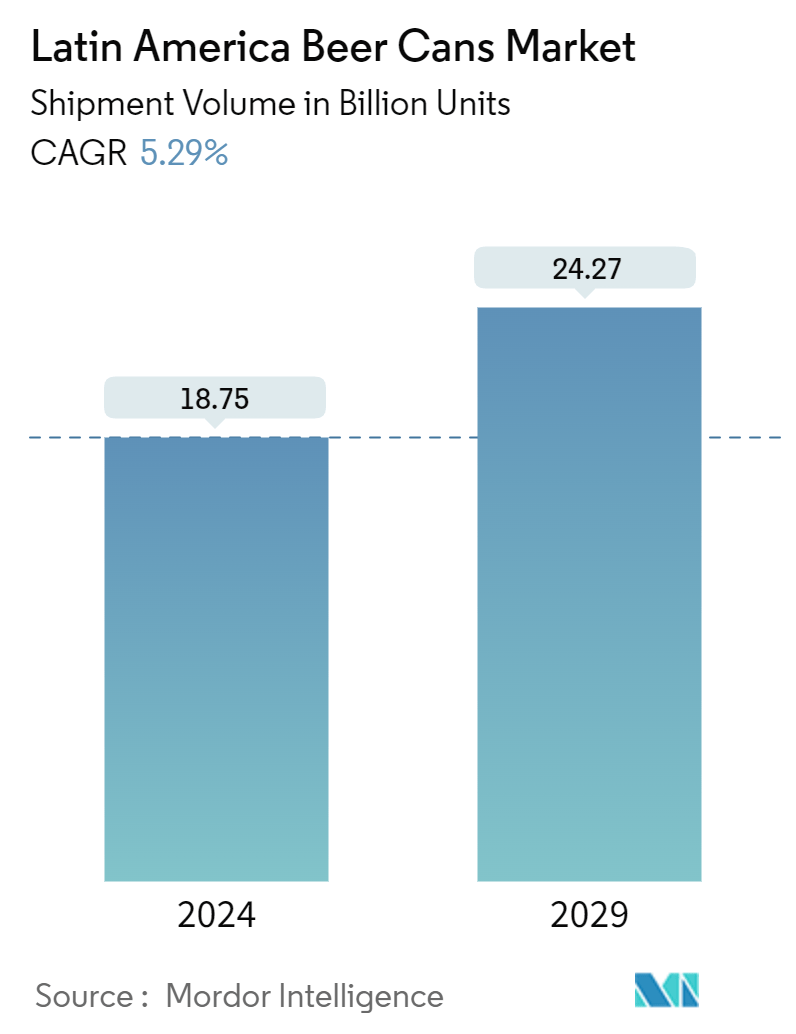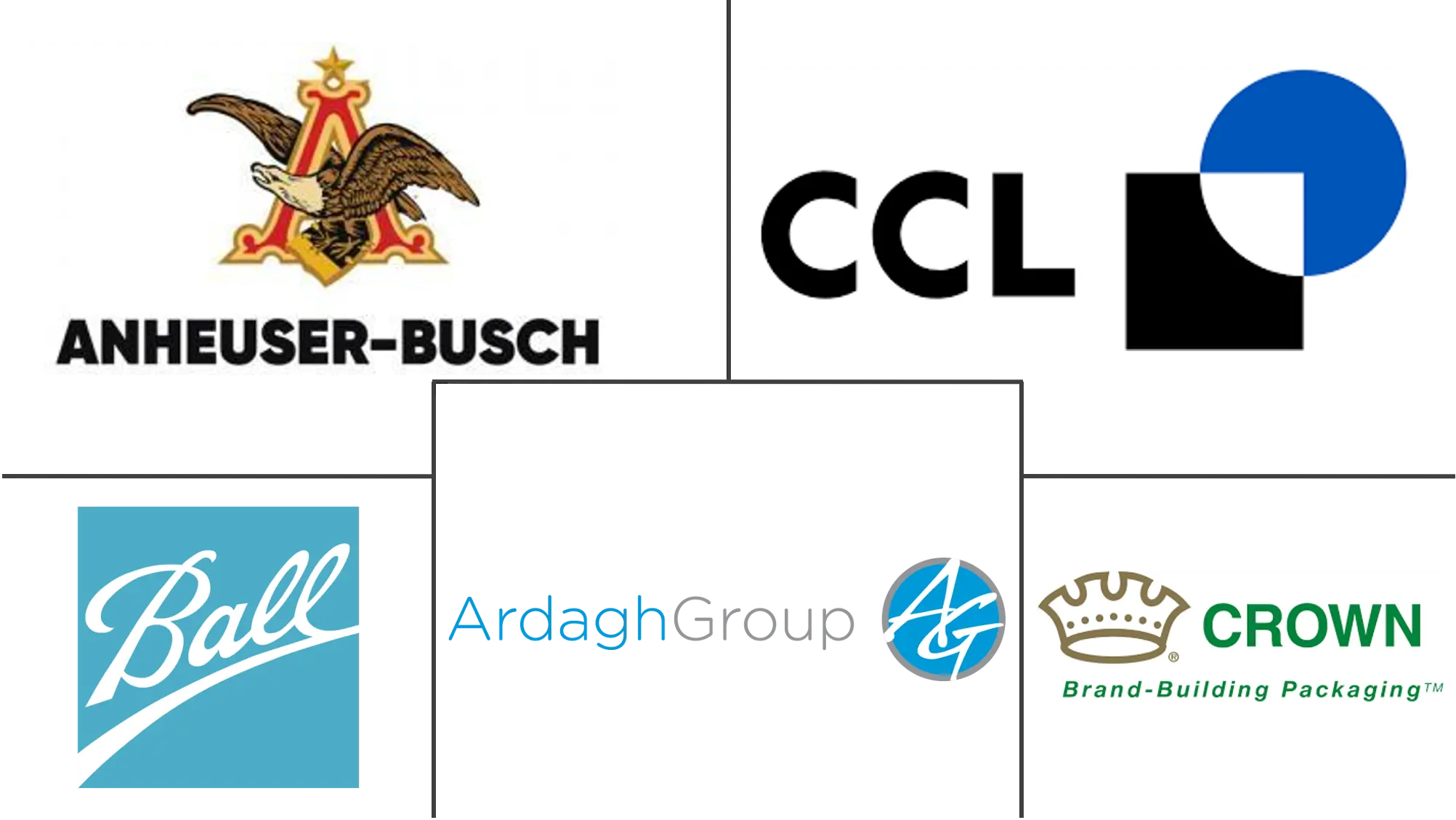Market Size of Latin America Beer Cans Industry

| Study Period | 2019 - 2029 |
| Base Year For Estimation | 2023 |
| Market Volume (2024) | 18.75 Billion units |
| Market Volume (2029) | 24.27 Billion units |
| CAGR (2024 - 2029) | 5.29 % |
| Market Concentration | High |
Major Players
*Disclaimer: Major Players sorted in no particular order |
Latin America Beer Cans Market Analysis
The Latin America Beer Cans Market size in terms of shipment volume is expected to grow from 18.75 Billion units in 2024 to 24.27 Billion units by 2029, at a CAGR of 5.29% during the forecast period (2024-2029).
The beer cans industry has seen significant growth, driven primarily by changing customer preferences for diverse tastes and flavours in beer. Lightweight and durable, aluminium cans outshine glass bottles in transport ease. Modern urban consumers in Latin America gravitate towards these cans, drawn by their convenience for outdoor activities, parties, and gatherings.
- The adoption of sustainability with environmental measures is expected to drive the market. Cans are permitted in many places where bottles are typically not allowed, such as beaches, pools, parks, campgrounds, ballparks, golf courses, boats, etc. Cans are 100-percent recyclable with other benefits such as much lighter than bottles, and requiring less fuel to ship them, whether empty or filled, is an added advantage. An empty 12-ounce bottle weighs about 7 ounces, whereas an empty can weighs only about a half-ounce.
- Brazil's government plays a significant role in boosting local beer manufacturing. For instance, in June 2024, Brazil inaugurated its largest malt production facility, Maltaria Campos Gerais. Situated on PR-151, between Ponta Grossa and Carambeí, this advanced plant is primed to cater to roughly 20% of the nation's malt requirements. Boasting a robust annual production capacity of 240,000 tons, the facility stands ready to make a substantial impact on Brazil's brewing sector.
- Further, the growing environmental concern in Mexico is forcing beer companies to adopt plastic-free cans. Grupo Modelo, a significant player in Mexico's beer brewing, distribution, and sales, has recently allocated approximately USD 4 million towards a sustainable packaging initiative in collaboration with WestRock and Grupo Gondi. Their fibre-based CanCollar Eco product is set to eradicate plastic rings in Mexico, commencing in Quintana Roo, thereby eliminating 12 million plastic rings yearly.
- However, consumers' preference for wine might challenge the market due to the increasing affordability of wine and liquor products. This shift is expected to continue, making more consumers shift towards these commodities. For instance, according to Jefferies & Company, the Brazilian alcoholic beverage market is expected to be around USD 121 billion in 2027, accounting for less than half of the US alcohol market.
- Moreover, the ongoing Russia-Ukraine conflict has significantly influenced the growth of the studied market. As a leading global aluminium producer, Russia's output has faced disruptions due to economic sanctions targeting its metal exports. This affects the availability of raw materials needed for manufacturing beer cans in Latin America.
Latin America Beer Cans Industry Segmentation
Brewers and beer consumers alike favour cans as a packaging choice. Cans effectively limit exposure to light and oxygen, are cost-efficient for transportation, and boast easy recyclability. The study analyzes the beer industry's expansion and demand for beer cans in the Latin American region. Canned packaging is critical in the beverage's production, transport, and sale.
The Latin American beer cans market is segemnted by packaging type (aluminium cans and steel/tin cans) and country (Mexico, Brazil, Argentina, Colombia and the Rest of Latin America). The market sizes and forecast are provided in terms of volume (units) for all the above segments.
| By Packaging Type | |
| Aluminium Can | |
| Steel/Tin Can |
| By Country | |
| Brazil | |
| Mexico | |
| Argentina | |
| Colombia | |
| Rest of Latin America |
Latin America Beer Cans Market Size Summary
The Latin America beer cans market is poised for significant growth, driven by the region's high alcohol consumption and substantial contribution to global beer consumption. The market is benefiting from the increasing adoption of sustainable practices, with aluminum cans gaining popularity due to their recyclability and logistical advantages over glass bottles. The Brazilian government is actively supporting local beer production, with initiatives like the collaboration between the Communist party government and AmBev to launch sustainable beer products. In Mexico, environmental concerns are prompting innovations such as plastic-free cans, exemplified by Corona's Fit Packs. However, the market faces challenges from shifting consumer preferences towards wine and liquor, particularly in countries like Argentina, where wine consumption is notably high.
The COVID-19 pandemic initially disrupted the market, leading to factory shutdowns and decreased demand for metal cans. However, the gradual reopening of markets and the resumption of production activities are expected to restore demand. Brazil's robust beer industry, supported by a large number of breweries and the presence of major can manufacturers, is a key driver of market growth. The country's initiatives in recycling and sustainable packaging further bolster the market. In Mexico, the craft beer segment is experiencing rapid expansion, with significant investments in new breweries and production facilities. The exclusion of aluminum and steel tariffs from trade agreements also supports the market's growth. Prominent players like Ball Corporation and Crown Holdings, Inc. are central to the market, with ongoing investments and partnerships aimed at enhancing recycling efforts and expanding production capabilities.
Latin America Beer Cans Market Size - Table of Contents
-
1. MARKET INSIGHTS
-
1.1 Market Overview
-
1.2 Industry Attractiveness - Porter's Five Forces Analysis
-
1.2.1 Bargaining Power of Suppliers
-
1.2.2 Bargaining Power of Buyers
-
1.2.3 Threat of New Entrants
-
1.2.4 Threat of Substitutes
-
1.2.5 Intensity of Competitive Rivalry
-
-
1.3 Industry Value Chain Analysis
-
1.4 Impact of Key Macroeconomic Trends on the Market
-
-
2. MARKET SEGMENTATION
-
2.1 By Packaging Type
-
2.1.1 Aluminium Can
-
2.1.2 Steel/Tin Can
-
-
2.2 By Country
-
2.2.1 Brazil
-
2.2.2 Mexico
-
2.2.3 Argentina
-
2.2.4 Colombia
-
2.2.5 Rest of Latin America
-
-
Latin America Beer Cans Market Size FAQs
How big is the Latin America Beer Cans Market?
The Latin America Beer Cans Market size is expected to reach 18.75 billion units in 2024 and grow at a CAGR of 5.29% to reach 24.27 billion units by 2029.
What is the current Latin America Beer Cans Market size?
In 2024, the Latin America Beer Cans Market size is expected to reach 18.75 billion units.

